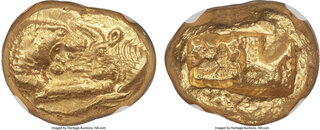| Heritage World Coin Auctions > NYINC Signature Sale 3113 | Auction date: 8 January 2024 |
| Lot number: 31031 Price realized: 50,000 USD (Approx. 45,580 EUR) Note: Prices do not include buyer's fees. | Show similar lots on CoinArchives Find similar lots in upcoming auctions on |
| Lot description: Ancients LYDIAN KINGDOM. Croesus (561-546 BC). AV stater (15mm, 8.09 gm). NGC Choice MS 5/5 - 5/5. Croeseid "light" standard, Sardes, ca. 550-546 BC. Confronted foreparts of lion right and bull left, both with outstretched foreleg / Two incuse square punches of unequal size, side by side, with irregular interior surfaces. Carradice 8. BMFA 2073. SNG von Aulock 2875. This exemplary piece, radiating a vibrant marigold tone, only enhanced by its silky, glimmering surfaces that dance captivatingly under the light. Crafted from fresh, pristine dies, it embodies a blend of elegance and radiance. In numismatic circles, Croesus is most famous for introducing the world's first bimetallic standard, issuing coins of both gold and silver. Prior to this, coins were produced in electrum, a naturally occurring alloy of gold and silver. This situation obviously caused a number of problems, most notably because the proportions of gold to silver were inconsistent. In fact, there is strong evidence to suggest that Croesus' father, Alyattes, artificially manipulated the gold-to-silver ratio in his electrum coins in his favor; the natural occurring electrum in Asia Minor typically has a gold-to-silver ratio of 75%-25%, though his coins were struck with 54% gold and 44% silver. The eminent scholar of early coinage, John Kroll, argues that the gold standard of Croesus was introduced in several stages, designed at recalling as many of the circulating electrum staters as possible. The early electrum staters of Asia Minor were typically struck on a weight standard of 14.15 grams. Considering the relative value of gold to silver at the time was 1:13, then one gold stater of the so-called "heavy" series of King Croesus, based on a weight standard of 10.8 grams, would have been equal to the gold and silver content of one electrum stater, which circulated at an assumed ratio of 75% gold and 25% silver. Kroll argues that the Lydian government used this heavy standard to recall the old electrum coins and reissue the new heavy standard gold coins at a 1:1 ratio. Once a sufficient number had been recalled, the Lydian government issued the new light stater, which weighed approximately 8.05 grams. Kroll continues his argument that this new weight standard was designed to recall as many of the remaining electrum coins as possible, as the 8.05 gram standard is based on the actual gold and silver content of early electrum coins (54% gold and 44% silver). In other words, the heavy standard was used to replace electrum staters at their circulating face value and the light standard was used to recall coins at their actual gold and silver value. https://coins.ha.com/itm/ancients/greek/ancients-lydian-kingdom-croesus-561-546-bc-av-stater-15mm-809-gm-ngc-choice-ms-5-5-5-5/a/3113-31031.s?type=DA-DMC-CoinArchives-WorldCoins-3113-01082024 HID02906262019 © 2023 Heritage Auctions | All Rights Reserved Estimate: 50000-70000 USD |  |



